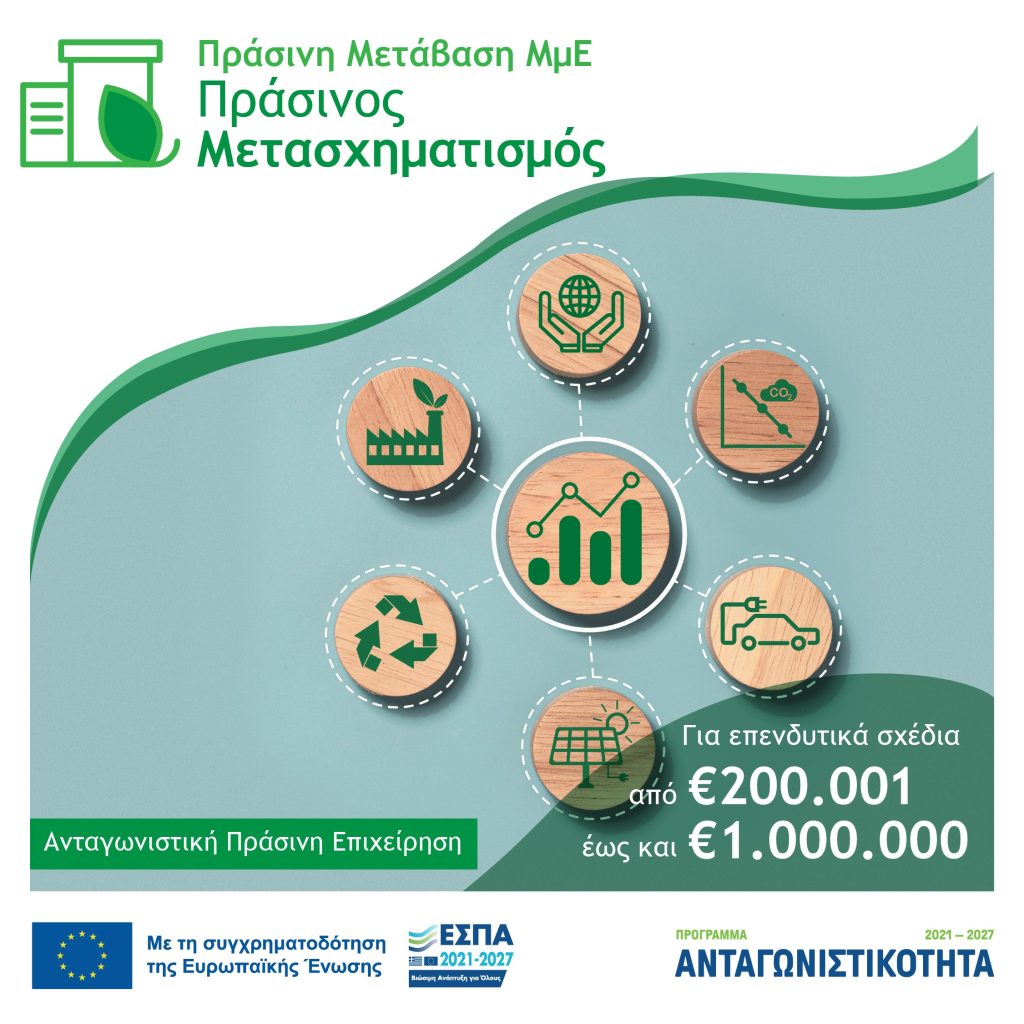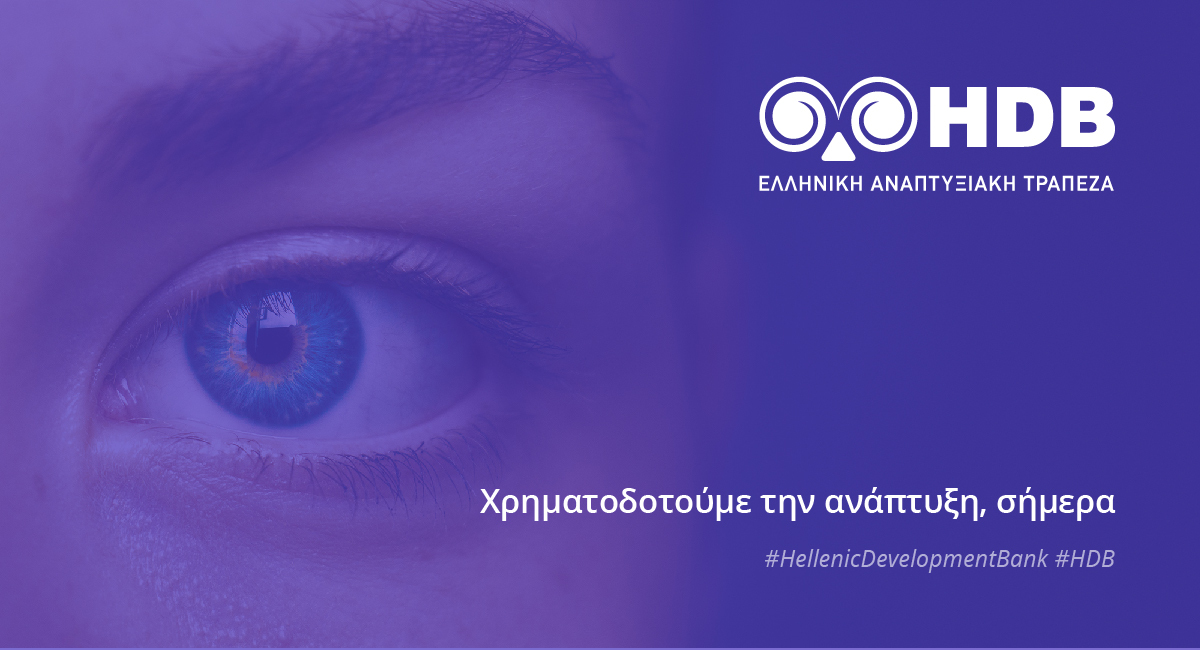
The Green Transformation SME Action is open to businesses that employ at least three (3) FTEs in the calendar year preceding the submission of the funding application.
Green Transformation SME Grant Rate: up to 40% - except in special cases (West Athens, East Attica, West Attica, Piraeus, Islands) that follow the EU Regulation 651/2014 (Article 14) whose rates are described in detail in the Call.
The grant may receive an additional 10% if it includes "Green Transition" GREEN costs up to 20% of the eligible budget of the investment project at the time of the investment project's inclusion. The above increased rate of grant will remain constant during the intermediate verification and payment stage.
The subsidised budget of the Green Transformation SME investment project can range from 200.001€ to 1.000.000€
TYPICAL CONDITIONS - Green Media Transformation
Question 1: In case the Activity Code with the highest revenue is used to fulfil the formal condition ii "operating in a Main Activity Code or in an Activity Code with the highest revenue" of section 4.1 of the detailed invitation, which year's data are taken into account?
Answer: In order to meet formal condition (ii) of section 4.1 of the detailed invitation, the data of the full closed financial year relating to the year preceding the submission of the funding application and for which the tax forms have been submitted to the AADE are taken into account.
Question 2: Is there a requirement to submit a licensing document when applying for funding?
Answer: The licensing document requirement applies to one of the IDs available to the business, if there is a requirement. In case a company has an IDs for which an authorisation document is required and IDs for which it is not required, it will be required to submit at least one authorisation document.
Question 3: Is a company upon submission required to submit an authorisation document for the investment ID(s)?
Answer: The company is not required to submit a licensing document for the investment ID(s) at the stage of applying for funding.
Question 4: The call states that "A company may submit one (1) new application for funding only if its previous application has been rejected and it has not proceeded to submit an objection or has already voluntarily withdrawn its objection". In case of voluntary withdrawal, will he be entitled to 1 or 2 more submissions if the initial one has not been evaluated?
Answer: In accordance with section 4.1 "Beneficiaries - General Conditions of Participation" and chapter 9 "Procedure for submitting the application for funding", enterprises may submit one (1) more new application for funding in the following cases where: a) there has been a written voluntary withdrawal of their previous application for funding (before the start of the evaluation), b) their initial application has been rejected, c) they have not proceeded to submit an objection, d) they have voluntarily withdrawn their previous objections.
Question 5: Businesses operating in the tourism sector (code 55) must comply with the requirements of paragraph 5.3 at the date of submission of the application for funding. "ELIGIBLE AREAS OF ACTIVITY FOR TOURIST HOTELS" (e.g. a hotel with a 3*** star classification is eligible for the action);
Answer: The conditions of paragraph 5.3 of the detailed invitation refer to the minimum restrictions that investment projects with investment code "Accommodation" (code 55) of the Tourism Sector must comply with at the stage of completion and acceptance of the project. For example, a hotel with a 3* (three-star) classification may apply for funding under the action provided that upon completion of the investment project it will be classified in category 4* (four-star) and above with a capacity of twelve (12) beds or more, always in compliance with the other conditions of the action.
Question 6: For the investment projects with investment code "Accommodation" (code 55) in the tourism sector, which will be submitted under the option of the financial scheme of Regulation E.E. 651/2014 (GAC), how is the fulfilment of the character of the initial investment in the case of "Fundamental change of the entire production process of an existing unit" demonstrated?
Answer: For the tourism sector (KAU 55 Accommodation), in order for the initial investment requirement to be considered as a fundamental change in the production process of an existing establishment, the investment project must , through the expenditure of the investment project either a comprehensive modernisation (upgrading of equipment, buildings and other facilities as well as the operational level of the enterprise) or an upgrade of the classification category (e.g. from 3* to 4*). In any case, the fulfilment of the initial investment character will be examined at the stage of the assessment of the investment projects.
Question 7: Do sole proprietorships have an obligation to register in the Register of Beneficial Owners?
Answer: Sole proprietorships are not required to register in the Register of Beneficial Owners as the beneficial owner is considered to be the entrepreneur/owner.
Question 8: For enterprises with a financial year 01/07 - 30/06, whose years' financial data are taken into account for the determination of their size?
Answer: In order to determine the size of the beneficiary enterprise, based on the definition of Commission Recommendation 2003/361/EC, the financial data of the last two (2) closed fiscal years for which the appropriate tax forms have been submitted (e.g. tax forms E3 & N) are attached.
Question 9: On the basis of which year is the calculation of the FTEs used to check the fulfilment of the standard requirement of three (3) FTEs?
Answer: For the fulfilment of the standard requirement of three (3) FTE of dependent work, the data of the calendar year preceding the submission of the application for funding are taken into account. E.g. in the case of an enterprise applying for funding in April 2023, the fulfilment of the above condition will be examined on the basis of the PF ERGANI or EFKA-NAT for the period from 1/1/2022 to 31/12/2022.
Question 10: A potential beneficiary applying for funding under the Green Transformation of SMEs action, under Article 14 of Reg. EU 651/2014, transferred its headquarters from the region of Attica (Region in Transition) to Sterea Greece (Less Developed Region) during the previous year of the funding application.
It fulfils the formal condition of participation a/ 21 of the Call for Proposals of the Action which stipulates that:
In the event that undertakings opt for the aid scheme under Reg. EU 651/2014 (GAC) to confirm that, in the two years preceding the application for aid, have not relocated to a business establishment in which the initial investment for which aid is requested has been carried out, and undertake not to do so within a maximum period of two years after the completion of the initial investment for which aid is requested (only for undertakings submitting on the basis of Article 14 of Reg. EU 651/2014);
Answer: This transfer of the registered office is not an exclusion criterion, as according to Article 14 of EC 651/2014, relocation is defined as "the transfer of the same or a similar activity or part thereof from a business establishment in the territory of a Contracting Party to the EEA Agreement (initial establishment) to a business establishment in which the aided investment takes place in the territory of another Contracting Party to the EEA Agreement (aided establishment)" (see Table of Explanation of General Terms and Abbreviations).
Green Media Transformation: SUPPORTING DOCUMENTS/RATING CRITERIA
Question 11 : Who should sign the Technical Report to document the initial investment?
Answer: There is no requirement for the Technical Report to be signed by an engineer, but it is required to have substantial evidence to support the original investment. Only in case the investment project includes capacity expansion , an Engineer's Declaration is required in case the existing capacity is not foreseen/certified by official documents (e.g. operating licence or any other public authority document) with reference to the production capacity.
Question 12: The investing entity has decided to carry out a capital increase using cash and submits bank statements showing the available balances of the partners/shareholders' accounts. Should he/she also bring the average available balances of the month prior to the month of the funding application?
Reply : Yes, you will have to submit both. The amount accepted is the lesser of the above two and the dates of the balances should be the same for all bank statements of the partners/shareholders.
Question 13: For a company applying for funding under the De minimis Regulation on 30/06/2023, for the documentation of the own contribution under point E of Annex I (SUB-FUNDING OF PROFESSIONAL BANK ACCOUNTS), what period should the certificate cover?
Answer: The certificate must necessarily include the period from 01/01/2023 to 31/03/2023, and may include more than one quarter, up to one year prior to the month of submission of the funding application (consecutive and full quarters) between 01/06/2022 and 31/05/2023. The dates for completing quarters are defined as 31/3, 30/6, 30/9 and 31/12. If more than one company account is used as proof of private participation, the time period of their average balances must be the same.
Question 14: In order to guarantee the private participation of the investment project, can Bank Statements, which indicate the available balances of the partners/shareholders' accounts, be combined with Bank Statements of Professional Accounts?
Answer: They may be combined only in the case of an application for funding under the de minimis scheme.
Question 14 A: If the EU Regulation 651/2014 is selected, at the time of submitting the funding application, what percentage must the financial participation data of the beneficiary of the aid cover?
Answer: In the case of the EU Regulation 651/2014 option, when submitting the application for funding, the evidence of the possibility of covering the financial contribution of the beneficiary of the aid must document the coverage of at least 25% of the eligible costs of the business plan, either through own resources or external financing, and in a form that does not contain elements of State aid.
Question 15: When applying for funding, under the regime of the EU Regulation 651/2014 (GAC), does the submission of e.g. a building permit, an installation permit or other relevant licensing approvals for the assessment of criterion C3 "Licensing Requirements" affect the completeness of the "incentive character"?
Answer: According to Article 1 of Regulation 651/2014 "preparatory works, such as obtaining permits and feasibility studies, are not considered as the start of works". Therefore, the issuing of licences does not alter the 'incentive character'.
Question 16: If the company is a member of an organised uniform distribution network of products or services, should the SME's declaration be signed by a Chartered Accountant?
Answer:The SME Declaration of Responsibility must be signed by a Chartered Accountant. If the SME Declaration is signed only by the Beneficiary, it must be accompanied by a Chartered Accountant's Report on the size of the business.
ELIGIBILITY OF EXPENDITURE
Question 17: What date is taken into account for the start of operations and the eligibility of expenditure of an enterprise's investment project in the case of an initially rejected application for funding and a new application for funding?
Reply : The date of the new application for funding is taken into account as the starting date for the investment project.
Question 18: Is expenditure on the purchase of computers and similar equipment eligible?
Answer: The costs for ICT equipment (hardware & software) are eligible only if they are necessary for the operation of the assisted production machinery.
Therefore, when implementing the Green Transformation SME investment project, the ICT equipment should be included in the same invoice or contract as the new assisted production machinery. Alternatively, the supplier of the assisted production machinery should explicitly specify (e.g. in a tender or other official document) the necessity of the ICT equipment for the proper functioning of the assisted production equipment.
Question 19: According to the detailed invitation in Annex I of the Application Documents, it is stated that two (2) tenders for each expenditure of categories 1 to 9, with a net value of more than 50.000€, must be submitted during the submission of the funding application. Does this requirement apply at the level of expenditure or category of expenditure?
Answer: This requirement applies to each discrete physical item, at the level of (recording) expenditure in the IPSAS, regardless of the category to which it belongs. It should be noted that the single expenditure for the same physical object should not be split to avoid this obligation. If at least two (2) tenders are not submitted, the expenditure in question shall be rejected.
Only in the event that it is not possible to submit a second tender (e.g. special constructions etc.), one (1) accompanied by relevant documentation shall be submitted.
Question 20: Is the expenditure category 11 "Indirect Costs" mandatory for both aid schemes (De minimis Regulation 1407/2013 and GAC Regulation 651/2014) and how is it included in the proposed subsidised budget of the investment project?
Answer: This category is only mandatory for investment projects to be supported under Reg. De minimis 1407/2013 and does not constitute eligible expenditure for Reg. GAC 651/2014. Indirect costs are calculated on the basis of a fixed rate of 7% of the total direct eligible costs of the operation and are included in the total subsidised budget of the investment project.
For example, for a funding application for the Green Transformation SME action, with a total Grant Budget of
252.520€:
Total Granted Budget Direct Expenditure Direct Expenditure 236.000€
Indirect Costs: 236.000€ × 7% = 16.520€.
Therefore 236.000€ + 16.520€ = 252.520€
Question 21: In category 3 "green equipment" and in particular in subcategory 3.3 equipment concerning the installation of photovoltaic plants and storage systems for electricity production and self-production:
a) is the cost of installing net metering eligible?
(b) can the electricity produced be fed into the grid and offset against the electricity consumed, or should the electricity produced be used exclusively to meet the needs of the business?
c) the installed capacity may exceed 10kW and will it be for the subsidy of a single connection contract with the TEN-T;
Answer: α) Yes, the cost of installing net metering is eligible under category 3.3 and concerns the supply and installation of photovoltaic power plants up to 10kW, storage systems for electricity production and smart meters and telemetry (smart metering).
b) The electricity produced can also be fed into the grid to be offset against the energy consumed (self-generation through energy offsetting).
The management of the storage systems (batteries) aims to maximize the self-consumption of the energy produced by the PV plant. During the operation of the system (PV with battery) the energy produced by the PV station is primarily channelled to the beneficiary's consumption. Any excess production is channelled into the storage system until it is filled and only when this has been done, the available energy of the PV can be injected into the grid. In periods when the energy produced by the PV station is not sufficient to cover the beneficiary's consumption, these are covered primarily by discharging the storage system and secondarily by absorbing energy from the grid.
c) The installed production capacity of the photovoltaic power plant is specified in the Connection Agreement, as it results from the agreed consumption capacity of the company, the energy needs that the company aims to cover, the electromechanical study of the installation in which the photovoltaic power plant to be connected is installed, from the operating license of the company, and/or from a certificate and other appropriate documentation from a competent person/agency. However, the subsidy is given up to a maximum of 10kW of installed PV capacity. In any case, the subsidy will vary according to the connection contracts the company has concluded with the DEDDIE.. If there is e.g. Connection Contract 15kW - then it can be accepted, but it will be subsidized for 10kW and the remaining 5kW will have to be covered with available resources of the company.
Question 21 A: In the subcategory of equipment expenditure 3.3 concerning the installation of photovoltaic plants and storage systems for electricity production and self-production, are the costs of storage systems eligible?
Reply : With regard to expenditure 3.3 'Equipment for the installation of photovoltaic stations and storage systems for electricity production and to cover own needs', expenditure on storage systems is eligible only when combined with the supply and installation of new photovoltaic stations, involving the storage of energy produced by them, the storage system absorbs at least 75 % of its energy, on an annual basis, from directly connected renewable energy production installations and are elements of a single investment.
Green Transformation of SMEs: PROCESS FOR IMPLEMENTATION - MONITORING OF ACTIONS
Question 22: Is relocation, during the implementation phase, to another Region allowed?
Answer: During the implementation stage of the investment projects, the beneficiaries must not relocate the aided investment outside the region of establishment. For the Region of Attica for investment projects implemented in accordance with Article 14 of Regulation 651/2014, the approved aid intensity must not be affected.
Question 23: At the completion of the investment project, is there an obligation to maintain the new staff's wage and salary records?
Answer: The requirement to maintain the PPAs does not concern the new personnel subsidised under expenditure category 10 (wage costs of new employees), but the obligation of the enterprise, at the completion of its investment project, to maintain, during the 12 months preceding the submission of the final verification request, the PPAs of salaried employees that it had in the 12 months preceding the submission of the application for financing of the investment project.
In the calculation of the maintenance of the PPAs, the subsidised PPAs of the enterprise for the period of time subsidised by the Action are not taken into account. In the event that the undertaking retains the additional PPAs beyond the period for which they were granted, they are counted in the above calculation.




